
MANUFACTURER'S SPECIFICATIONS AM-5 Tuner
Sensitivity: 3µV for 10 dB S/N.
AGC Characteristics: Less than 6 dB output variation from 10 µV to 10 mV r.f. input level. R.F. Bandwidth-3 dB: Narrow, 6 kHz; Wide, 20 kHz. Image Rejection: 70 dB. Adjacent Channel Rejection: 70 dB. I.F. Rejection: 45 dB.
Frequency Response: Wide, 15 Hz to 9 kHz,-3 dB.
THD, 1 kHz Modulation: 0.5% at 30% mod.; 1.0% at 50% mod.; 1.5% at 80% mod.
Audio Output: 1 V rms, (5000 Ohm output).
Power Requirements: 110-120/220-240 V/a.c., 50/60 Hz, 30 watts.
Net Weight: 8 albs. (3.97 kg).
Dimensions: 17 ½ in. (44.5 cm) W x 3 1/2 in. (8.9 cm) H x 10 in. (25.4 cm) D.
Suggested Retail Price: $295.00. (Also available with balanced 150-600 Ohm output at extra cost. Supplied with wood ends or 19-in. rack mount.)
---------------------
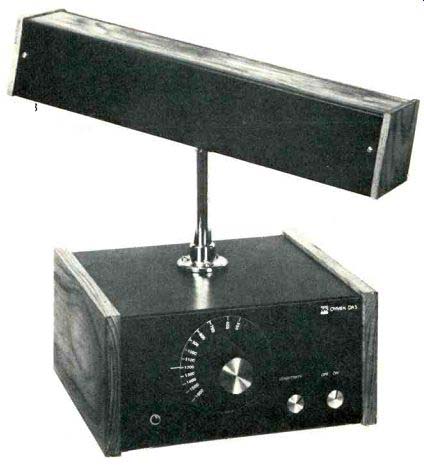
DA-5 Antenna
Frequency Range: 540 to 1600 kHz.
Output Impedance: 50 Ohms.
Sensitivity Adjustment Range: 40 dB.
Type: Tuned preamplifier with shielded ferrite loop.
Ferrite Rod Dimensions: 12 in. (30.5 cm) L x 3/4 in. (1.9 cm) diameter.
Overall Dimensions: 13 3/8 in. (34 cm) W x 9 1/16 in. (23.3 cm) D x 11 in. (28 cm) H.
Weight: 6 ¼ lbs. (3.06 kg).
Suggested Retail Price: $175.00.
Before everyone experiences a collective deja vu, let me reassure you all that, yes, you have seen a pair of similarly configured McKay Dymek products in Audio magazine before. The McKay Dymek AM-3 tuner and DA-3 antenna were tested and reported on in the December, 1974 issue of this publication. While we do not know what ever happened to (or if there ever were) AM-4 and DA-4 McKay Dymek models, we can attest to the fact that the AM-5 and DA 5 units tested here represent more than just a cosmetic change and a price increase (the AM-3 used to sell for $255.00, while the antenna sold for $155 in its earlier version). As impressed as we were with the old AM-3, we are happy to advise all you AM fanciers that the AM-5 is even better. Specifically, the AGC circuit is "tighter" and frequency response is actually somewhat more extended than before. But perhaps we're getting ahead of ourselves (particularly for newer readers of Audio who may have missed the earlier reports). Countering the trend towards mediocre AM circuitry normally found in high fidelity components, George McKay of Pomona, California introduced the Dymek tuner (originally built overseas) to the AM-DX buffs of America a few years ago. They welcomed it enthusiastically, confirming what they had long suspected: that AM radio can be hi-fi if a proper receiver is used and if AM radio stations take the trouble to lease high-fidelity telephone lines between studio and transmitter. Inspired by this early success, McKay now manufactures the latest version of the tuner (the currently tested AM-5) and the unusual DA-5 AM indoor antenna in the United States.
The newest version of the tuner looks very much like the high fidelity component it is. The black metal panel, framed at each end by attractive teak wood end panels, has a long, well-calibrated (if dimly illuminated) dial scale, large tuning knob, and signal strength "S" meter along its upper half.
The lower left section of the panel has five rectangular shaped metal push-buttons which turn power On and Off as well as select distant or local reception (in the local position, 30 dB of attenuation is inserted in the antenna input circuitry) and between wideband or narrow band operation of the i.f. filter.
The back panel of the AM-5 has a single output jack (Yes, Virginia, AM is still mono.), a phono-jack type AM antenna connector (for connecting a coaxial type "lead-in" wire), a pair of screw terminals for single wire antenna and ground connection, an output level control, and a pair of convenience a.c. receptacles. A slide switch permits changeover from 120 to 220 V power lines, and a line fuseholder is also located on the rear panel. The "covered over" area seen in ... Fig. 1 obscures the area which would contain the 150-600 Ohm balanced output option.
Construction and Circuitry
Figure 2 shows the internal layout of the AM-5 chassis. Five separate circuit board modules are used (r.f., i.f., power supply, antenna, and function selection), with a sixth added for the balanced output option (not present in our sample). A block diagram of the circuit is reproduced in Fig. 3. Following the antenna input is a dual element band reject filter to eliminate any incoming 455 kHz (i.f. signal). The switch able 30-dB attenuator (for "local" reception) comes next. A three-gang tuning capacitor is used, as are junction field effect transistors in the entire r.f. section. Cascode JFETs are used in the i.f. section, as are two ceramic ladder filters used to provide the switchable selectivity (wide and narrow bandwidth). Two double-tuned i.f. transformers also aid in establishing desired i.f. response. Separate detectors are used for audio and AGC circuits, with the former circuit employing a hot carrier diode detector. AGC voltage is derived through envelope detection and is carefully filtered before application to preceding stages. A sharp 10-kHz notch filter is included within the feedback loop of a pair of ICs in the audio section to provide 30 dB of rejection of heterodyne beats that might be caused by adjacent carrier signals. Dual polarity supply voltages are regulated by an IC.
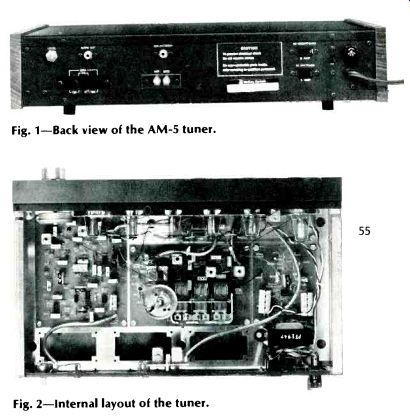
Fig. 1-Back view of the AM-5 tuner. Fig. 2-Internal layout of the tuner.
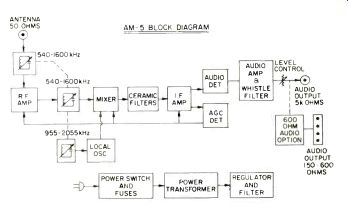
Fig. 3-AM-5 block diagram.
Laboratory Performance Measurements
While existing IHF measurements standards do not recognize the "10 dB S/N" sensitivity figure published by McKay Dymek, we confirmed this measurement, obtaining 10 dB of S/N for only 2.7 µV of signal applied. Using the more conventional sensitivity measurement technique, an input signal of 14 µV (at 30% modulation) was required for a 20 dB S/N+THD ratio. Ultimate S/N with strong signals was better than 53 dB. Audio output level was extremely uniform at all signal strengths above 100 µV and was "down" only 5 dB at 10 µV input signal strength, a measure of the outstanding AGC characteristic of the AM-5. It should be noted that the sensitivity measurement was made with the "narrow" set ting of the i.f. section. In the wide setting, sensitivity is understandably somewhat lower. I.f. rejection measured exactly 45 dB as claimed, while image rejection was better than claimed, measuring 83 dB. Distortion, though a bit higher than claimed at the 30% modulation level (0.7% as opposed to 0.5%), behaved nicely at higher modulation levels, with 1.1% THD at 50% modulation and 1.6% at 80% modulation levels.
Perhaps the most outstanding feature of the AM-5 is its uniform frequency response all the way out to 9 kHz (in the "wide" position of bandwidth). This capability is best illustrated in the spectrum analysis 'scope photo of Fig. 4. Note the action of the 10-kHz "whistle filter" in this trace. The filter's notch is not properly or adequately depicted in this trace because of the relatively fast sweep rate and the logarithmic sweep used for frequency response plots on the analyzer. By slowing down the sweep and altering it to a linear sweep covering only the range from 7500 Hz to 12,500 Hz (500 Hz per division, horizontally), we were able to obtain the photo shown in Fig. 5 which shows some 40+ dB notch capability of the steep notch filter at 10 kHz.
An additional response measurement was made in the Narrow bandwidth mode of the tuner, and results are presented in Fig. 6. Even at this reduced bandwidth setting, response is still quite flat to beyond 5 kHz (probably better than that obtained on typical AM sections of most stereo receivers and tuners). As reported in our earlier test of a McKay Dymek tuner, our local full-fidelity AM station is still pumping out wide-range audio programming-a fact that we could only appreciate by listening to it with a tuner such as this McKay AM-5. If you are fortunate enough to be near an AM station that also broadcasts wide frequency response (or even if you are relatively far from one, since the AM-5 will receive stations that are further away than you would believe), the AM-5 may shed a whole new light on the capabilities of AM broadcasting. I know you will find this hard to believe, but a newsletter sent out by the McKay Dymek company contained a letter from an AM-DX'er who actually claims to have picked up the broadcast band transmissions of Radio-France Inter (not short wave, broadcast band) at 1554 kHz on his receiver, using an older version of the McKay Dymek antenna (the previously reviewed DA-3), so let's go on to discuss this second product from McKay Dymek.

Fig. 4-Frequency with tuner set to "wide" bandwidth.
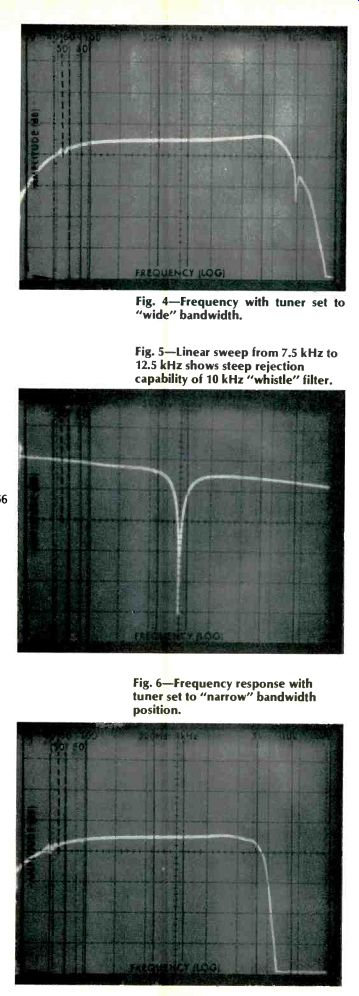
Fig. 5-Linear sweep from 7.5 kHz to 12.5 kHz shows steep rejection capability of 10 kHz "whistle" filter.
Fig. 6-Frequency response with tuner set to "narrow" bandwidth position.
The DA-5 from McKay Dymek seems to have undergone fewer changes than the AM tuner just discussed. It still has the rotatable ferrite shielded loop on top and the small box below containing a two-stage FET preamplifier which is tunable by means of a calibrated dial over the standard AM broadcast range of frequencies. A sensitivity control varies the gain of the system and a power On/Off switch (which also makes a direct-through connection to your existing outdoor AM antenna if you have one connected to your AM set) are the only other controls provided on the DA-5.
Since it does contain amplifying components, it needs to be connected to a power source (either 120 or 220 volts a.c., 50/60 Hz) but consumes a mere 2 watts in use. Choice of power source voltage is made by means of a small switch on the rear panel.
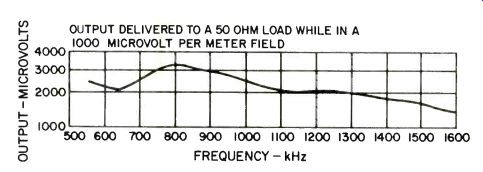
Fig. 7--Gain vs. frequency characteristic of DA-5 antenna (supplied by
manufacturer).
Obviously, the DA-5 can be used with any AM tuner or receiver that has a terminal for connection of an external AM antenna. Equally obvious is the fact that this device cannot improve the fidelity of your present AM equipment but it certainly can and does improve overall sensitivity as well as selectivity (because of the extra stages of tuning provided ahead of your normal antenna input). Because the ferrite rod can be rotated or tilted in almost any direction, you will probably find (as we did) that man-made noise can be substantially reduced when listening to AM. We were not able to make specific measurements of the "gain" of the DA-5 system, since that would have required a calibrated, known field of microvolts per meter. We are, however, reproducing a curve provided by the McKay Dymek people (Fig. 7) which represents the output delivered by the DA-5 to a 50 Ohm load over the entire broadcast band of frequencies when in the presence of a 1000 microvolt-per-meter field strength. Used in conjunction with the AM-5 tuner, this pair of products will provide you with AM reception second to none. Perhaps the most fitting way in which to summarize this report might be to quote, verbatim, the final paragraph of our earlier, 1974 test report concerning the antecedents of this current pair. The words fit even better, now.
"Certainly, the limitations imposed by AM broadcasting techniques in general may discourage a great many audio buffs from rushing right out to spend $295.00 (sic) for the AM-5 (sic) or even $470 (sic) for the combination of DA-5 and AM-5 (sic). For those who enjoy AM-DX'ing, and for those fortunate enough to be served by an AM station that does broadcast wide response audio (a phone call to your favorite station's chief engineer should provide you with the needed information), here at last is a pair of products that successfully concentrates on good AM performance." Incidentally, McKay Dymek products are sold through mail order only. You can call a toll-free number (800-8547769 nationwide, 800-472-1783 in California) or write directly to McKay Dymek Co., North Park Avenue, Pomona, CA 91766 if you are interested in obtaining further information about these unusual products.
-Leonard Feldman
(Source: Audio magazine)
Also see:
Marantz Model 2500 Stereo FM/AM Receiver (Feb. 1978)
= = = =